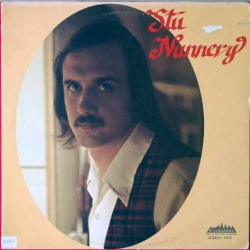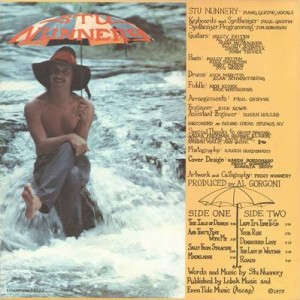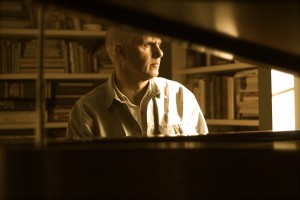Stu Nunnery Interview 2 – A Return to Music
Not long after launching ClassicRockMusicBlog.com, I tracked down a long silent singer/songwriter from the 1970s named Stu Nunnery, who agreed to an interview. The circumstances of our connection can only be described as cosmic serendipity. During the 1990s, I found a copy of Nunnery’s self-titled LP in the dollar bin of a used record store in St. Paul, Minnesota. I had never seen the record before, but it looked interesting and I bought it. When I put the platter on my turntable, I was immediately taken by the music. Here was a set of songs and an artist that should have found more popular favor in the 1970s, in the same vein as James Taylor or Jackson Browne, but it was not meant to be — at least then.
Little did either of us know—or expect—that five years after our first chat and 40 years after his lone LP release, Stu would be making a full-fledge return to music. This includes the long-overdue release on CD of his lone solo LP from 1973, writing new songs with plans to record a new album and doing what Nunnery loves best —performing live.
2013 promises to be a busy and exciting year for Nunnery and his fans. Stu and I talked recently about his unlikely return to music, the path ahead and how you and I can become involved and help this deserving artist return to his craft.
When we first spoke in 2008, you had been out of music for many years due to some incredible circumstances. Can you recap the events that took you out of your art?
Sure, a successful career in songwriting, music recording, singing, advertising (jingles), acting and live performing ended precipitously in 1981 when I suffered a series of catastrophic incidents to the blood vessels of my ears and eyes that at the time appeared to make anything forward professionally impossible. I continued however on my own, not publicly to sing and play the piano on occasion, and in the early ’90s appeared as an extra in television commercials and in a few independent and feature films (Philadelphia, Age of Innocence, Lincoln and Seward [PBS]). I have not recorded or performed live musically since 1981.
Some five years later you’re fully back into music. What happened? Was there a specific day you decided to start singing again, or to play guitar or piano?
As they always say it was a confluence of things, The first piece was the interview you and I did in 2008 when I learned really for the first time that there was — however large or small — an international fan base and that my music had resonance even after all these years. The Internet changed everything, but for some reason I had not sought out my work on the web until then. Once the interview hit I spent a lot of time re-finding myself and my place in that world. People wrote comments after the interview and I followed their trail but all I thought then really was that perhaps I could put my original album on CD — as many had asked me to do.
Secondly I’d have to say it was the death of my sweetheart in 2010 that brought my own life ever more into relief and I began to feel again that the one thing life had not given me was another chance at music and if there was any way I could, I would return. After she passed away, I redoubled my efforts.
Third was the evolution of hearing and sound technology. For more than 30 years I had assumed that I had a distortion to my hearing that would not allow me to perform again, as I couldn’t seem to hit pitch correctly with the piano. The latest news is that some of that distortion I was hearing was actually coming from the hearing aid. There’s been a lot of research in the past decade and even hearing specialists did not focus until recently on understanding that hearing voices and music are quite different. And I’m not alone. Many musicians – some estimates are 30% of rock and roll musicians and 52% of classical musicians — have some hearing loss. With new technology I received in 2010 I began hearing tones I hadn’t heard correctly for three decades, and I knew at that moment that I could at very least record again. That was a revelation and a very startling one, happily so.
The thing I have missed most was performing live. I am a singer but more completely a performer and am very comfortable on stage — in fact have done a lot of speaking and one-person performances around the country these past many years. To be able to sing and to interact with audiences again was what I wanted most. After I knew I could hear better, I started working with a vocal coach again. I did not spend the past 30 years on the road, so my voice is in very good shape. After a few lessons she told me that all the facets of my voice were there and that nothing should prevent me from doing again what I once did well. It was a matter of matching what I had and can hear with the right monitoring and amplification technology. As in fact, all musicians are doing today.
On my birthday in February of 2012 a woman I was dating and I walked into a restaurant in New Hampshire for a birthday dinner and the room was quiet but there was a baby grand piano staring at me. My friend suggested that I sit down and play — she knew the owner and he agreed. I played — just piano no singing — for about 45 minutes and the room pleasantly and unexpectedly responded and people wanted to know who I was. I hadn’t played for anyone for more than 30 years and my sweet friend said to me, “You can do this again.” Yes, I thought, I can get a bar gig, but could I do this on stage with musicians and an audience?
The answer is yes and the pieces are coming together in steps as you and I speak again — very exciting for me.
It’s a confluence — a history in music that is appreciated by others, serendipity, and some life- changing occurrences, technological advances, and a passion that would never die. So hello again! There are not only second acts in life; there are thirds — and maybe even more.
In the process, did you work to relearn all your original material?
What I’ve done is brought my performances of that music up to date and added nuances and subtleties to the playing and singing that I have perfected over these many years. That will change the songs — the older ones and the newer ones — for the better: New stylings — pop, rock, folk, country, jazz, alternative for example, and different tempos, expanded and/or simpler phrasing. I’m very anxious to get back in the studio and up on stage again. I’m a better singer and vocal performer than I was at 24.
2013 marks the 40th anniversary of your self-titled solo album, which is going to be reissued on compact disc for the first time. What took so long?
The reasons are in my response to your second question. All the processing I had to do to even believe I could move myself and my music to the next point. There’s 30+ years of bad road there. I had a lot to negotiate. Confidence played a role too. I was beat up at 29 at what should have been the beginning of my peak years.
Did you find the original masters or was it sourced from something else?
Perhaps not surprisingly I had always had in my possession the original master tapes for my first album. But those tapes had spent time in every kind of climate environment you can think of. By 1981, they seemed to have no value anymore to me though I held on to them. In 2012, after I began to see some light, I decided to get the tapes transferred to CD for later cutting, uploads and sales. My original engineer, Rick Rowe, suggested I work with Charles Harbutt at Long Tail Audio in New York. When I brought the tapes in, he felt he would probably have to “bake” the tapes, which involves putting them in a dry/low heat environment overnight to get them to at least be listenable. He didn’t promise the transfer would take. But he noticed as did I that the original piece of tape that held the master to the reel was still in place, suggesting that maybe the tape was in good shape. He was also pleased to see that it was Scotch tape which apparently has held up better over the years than its competitors. But when he asked me where I had stored them I had to laugh. I said everywhere from the Arctic to the Tropics and every place in between. He told me to call him the next day.
Instead he called me earlier than we had agreed and told me that the CDs (a master and copies) were ready. He said that when he put them on just to listen they were in excellent shape and didn’t need baking — even after 40 years. I have the master CD, which now only needs mastering to clean it up digitally for replication and copies.
Do you have any favorite moments from that LP?
During recording, working (both on my album and in later sessions) with the “studio cats” (with all due respect), who just blew you away with their skills, taste and ideas. I didn’t even realize then who I was working with — some of them very early in their own careers who would go on to incredible heights — but read the names. I was very fortunate to have had these gentlemen taking me forward — their work lives on with my songs. What an incredible treat. And what a mind-numbing loss not to be able to have enjoyed their mastery again throughout the years following my first album. I’m very happy to say I am still in touch with a few of them and may engage them in my work forward.
As for songs, I’m pleased with them all given the time they were produced and my abilities — and limitations — at the time. Al Gorgoni, my producer, did a masterful job with a rather eclectic list of tunes, as did Paul Griffin, our arranger, and Rick Rowe, our engineer.
I especially am fond of “Your Rise,” “Diminished Love,” “The Lady in Waiting” — and they weren’t even the “hits” — “Sally From Syracuse,” “Madelaine” and “Lady It’s Time To Go,” and even “The Isle of Debris” which became a rock classic in parts of the country. That’s seven of the nine cuts that had a very extended shelf life.
For releasing a single LP you had some significant success.
We did. Two songs, “Madelaine” and “Sally from Syracuse,” made the Top 100 on the American Pop charts, “Sally” went as high as #67. “Lady It’s Time To Go” became the #1 record in Brazil during 1976, and was covered by both Nicky Hopkins and B.J. Thomas. And as I mentioned before, “The Isle of Debris” was a rock favorite at stations across the country and really found a home as a classic tune at KSHE in St. Louis. There were other songs that became “turntable hits,” meaning they received lots of airplay around the world. Not bad really for first release.
Did you see any royalties from your first outing?
Very little – nothing in fact from record sales and very little publishing money from all that airplay, even from in Brazil where I had a #1 record for a time. Yet today you can buy my singles and album on vinyl disc and even sheet music in many countries. I saw my album on Amazon recently for $49.98. These are dollars I will probably never see. It was the dark ages then, and artists signed contracts that gave too much away in front for a shot at the music business. Record companies that paid the recording costs and promotion costs simply promised royalties only after they recouped their costs – so most of us never saw an accounting. In sum, I came out of my “successful” recording experience with less than very little.
What are your hopes for the reissue?
They are simply to address the requests of fans, and to re-establish my visibility and musical identity, and, of course, to bring new people to me and my music.
Where will it be available for purchase?
The 40th Anniversary Special Edition CD is being re-mastered and will be ready for mailing around the middle of June. We’ve set up a pre-ordering protocol available as soon as this interview hits the web. We can take your order right now!
You’re working on a collection of new songs for a new album. How did it feel getting back into writing after all these years?
I have never really stopped writing. For the past 30+ years writing has been the focus of much of my work — in between a host of odd jobs. I’ve worked as an activist and educator primarily around foods, farms, public health and local economies and have been written up in and written for every medium. All of that has facilitated my writing in whatever format for me. I will also be doing a lot of writing and performing for YouTube — music and performance videos, some advocacy work, and many others. As for writing music and lyrics, I’ve just had to shift my focus a bit to re-make those connections and it’s been very rewarding. I have a lot of material ready to be recorded. There’s more to say and a host of musical ways to say it. After performing, I’m always happiest writing in whatever form.
Was it harder or easier this time around?
My musical vocabulary is much larger than it’s ever been though I did not listen to a lot of music for many years. But I grew up during the hey-day of great singers and songwriters of the ’60s and ’70s, and that has left an imprint. Not harder or easier, but more compelling and infinitely more interesting. Trade secret: I also write for performance, not just records — so what sounds right to me are things that will fit inside a larger context in the studio and on stage. So I’m putting together a body of work for larger purposes, not just one knock-off after another. I love all styles of music and am writing in many of them. Seems to me it’s a writer’s paradise right now. I’m enjoying it.
How do your musical chops and voice today compare to when you were playing in the 1970s?
I have retained what was good, enhanced what I can, and am adding new touches that seem to fit me and who I am musically and vocally. Lyrically, I have a lot to say — always have — and am enjoying this platform again to say things in a unique way while riding on a wave of musical sounds.
The financial backing for recording this new album will largely be crowd-funded. What is your financial goal and what can fans do to help?
I’m building a patron base – much like artists and composers have done throughout history. I will also be crowd-funding some via the web. I will be selling CDs of my first album as well as new material on-line and wherever I perform after July. I’m becoming engaged in some other related artistic ventures (performance art, videos, PSA’s) from which I plan to generate revenues. I’d like to invite patrons, friends, fans and others who would like to join me in this next adventure by supporting my musical and performing arts forward. They can reach me through my Facebook Page and I will send them a personal invitation and a prospectus. Simply send me a personal message. I’ll get right back to you. With my thanks!
What are your musical plans for the rest of 2013 and beyond?
Moving the Stu Nunnery 40th Anniversary Special Edition CD and by mid-July, be back in the studio making new music. After that, live dates and other performance activities. In between, building the patron base, launching other artistic ventures, making connections, and being very, very busy – back at last doing what I was meant to be doing. And very grateful for it.
Stu Nunnery at the piano, 2013
You can pre-order the 40th Anniversary reissue of “Stu Nunnery” using the Paypal link below. Your support is greatly appreciated!




Wonderful interview of a compelling artist. Thanks!
This is a great release for veteran music lovers. Stu has a big following in a lot of different parts of the country (Syracuse in the northeast, Saint Louis in the midwest, for example), and I think this re-release is not only going to reignite interest from those areas, but generate a lot of new interest in other parts of the country as well.